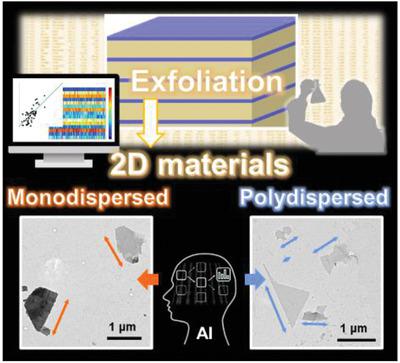当前位置:
X-MOL 学术
›
Adv. Theory Simul.
›
论文详情
Our official English website, www.x-mol.net, welcomes your
feedback! (Note: you will need to create a separate account there.)
Size-Distribution Control of Exfoliated Nanosheets Assisted by Machine Learning: Small-Data-Driven Materials Science Using Sparse Modeling
Advanced Theory and Simulations ( IF 2.9 ) Pub Date : 2021-09-06 , DOI: 10.1002/adts.202100158 Yuri Haraguchi 1 , Yasuhiko Igarashi 2, 3 , Hiroaki Imai 1 , Yuya Oaki 1, 3
Advanced Theory and Simulations ( IF 2.9 ) Pub Date : 2021-09-06 , DOI: 10.1002/adts.202100158 Yuri Haraguchi 1 , Yasuhiko Igarashi 2, 3 , Hiroaki Imai 1 , Yuya Oaki 1, 3
Affiliation

|
2D materials exhibit emergent properties originating from their characteristic nanostructures. In general, monolayered and few-layered nanosheets are obtained by exfoliation of the precursor layered materials. However, lateral-size distribution of the nanosheets is not easily controlled through the exfoliation because of the unpredictable down-sizing processes. The present work shows selective syntheses of transition-metal-oxide nanosheets with the monodisperse and polydisperse lateral sizes by the assistance of machine learning on small experimental data. The precursor layered composites of host transition-metal oxides and interlayer organic guests are exfoliated into the surface-modified nanosheets in organic dispersion media. A prediction model of the size distribution is constructed by sparse modeling, a method of machine learning, on the experimental data. The host-guest-medium combinations achieving the monodisperse and polydisperse lateral sizes are recommended by the prediction model. Therefore, the nanosheets with the controlled lateral-size distribution are selectively obtained in a limited number of the experiments. Moreover, self-assembly of the polydispersed nanosheets forms the homogeneous thin film exhibiting interference color. The prediction model and its construction method can be applied to the other 2D materials. Moreover, the present work implies that sparse modeling is an effective approach for small-data-driven materials science.
中文翻译:

机器学习辅助的剥离纳米片的尺寸分布控制:使用稀疏建模的小数据驱动材料科学
二维材料表现出源于其特征纳米结构的新兴特性。通常,通过剥离前体层状材料获得单层和少层纳米片。然而,由于不可预测的缩小尺寸过程,纳米片的横向尺寸分布不容易通过剥离来控制。目前的工作显示了通过机器学习对小型实验数据的辅助,选择性合成具有单分散和多分散横向尺寸的过渡金属氧化物纳米片。主体过渡金属氧化物和夹层有机客体的前体层状复合材料在有机分散介质中剥离成表面改性的纳米片。尺寸分布的预测模型是通过稀疏建模构建的,这是一种机器学习方法,在实验数据上。预测模型推荐实现单分散和多分散横向尺寸的宿主-客体-介质组合。因此,在有限数量的实验中选择性地获得了具有受控横向尺寸分布的纳米片。此外,多分散纳米片的自组装形成具有干涉色的均匀薄膜。该预测模型及其构建方法可以应用于其他二维材料。此外,目前的工作意味着稀疏建模是小数据驱动材料科学的有效方法。在有限数量的实验中选择性地获得了具有受控横向尺寸分布的纳米片。此外,多分散纳米片的自组装形成具有干涉色的均匀薄膜。该预测模型及其构建方法可以应用于其他二维材料。此外,目前的工作意味着稀疏建模是小数据驱动材料科学的有效方法。在有限数量的实验中选择性地获得了具有受控横向尺寸分布的纳米片。此外,多分散纳米片的自组装形成具有干涉色的均匀薄膜。该预测模型及其构建方法可以应用于其他二维材料。此外,目前的工作意味着稀疏建模是小数据驱动材料科学的有效方法。
更新日期:2021-10-04
中文翻译:

机器学习辅助的剥离纳米片的尺寸分布控制:使用稀疏建模的小数据驱动材料科学
二维材料表现出源于其特征纳米结构的新兴特性。通常,通过剥离前体层状材料获得单层和少层纳米片。然而,由于不可预测的缩小尺寸过程,纳米片的横向尺寸分布不容易通过剥离来控制。目前的工作显示了通过机器学习对小型实验数据的辅助,选择性合成具有单分散和多分散横向尺寸的过渡金属氧化物纳米片。主体过渡金属氧化物和夹层有机客体的前体层状复合材料在有机分散介质中剥离成表面改性的纳米片。尺寸分布的预测模型是通过稀疏建模构建的,这是一种机器学习方法,在实验数据上。预测模型推荐实现单分散和多分散横向尺寸的宿主-客体-介质组合。因此,在有限数量的实验中选择性地获得了具有受控横向尺寸分布的纳米片。此外,多分散纳米片的自组装形成具有干涉色的均匀薄膜。该预测模型及其构建方法可以应用于其他二维材料。此外,目前的工作意味着稀疏建模是小数据驱动材料科学的有效方法。在有限数量的实验中选择性地获得了具有受控横向尺寸分布的纳米片。此外,多分散纳米片的自组装形成具有干涉色的均匀薄膜。该预测模型及其构建方法可以应用于其他二维材料。此外,目前的工作意味着稀疏建模是小数据驱动材料科学的有效方法。在有限数量的实验中选择性地获得了具有受控横向尺寸分布的纳米片。此外,多分散纳米片的自组装形成具有干涉色的均匀薄膜。该预测模型及其构建方法可以应用于其他二维材料。此外,目前的工作意味着稀疏建模是小数据驱动材料科学的有效方法。











































 京公网安备 11010802027423号
京公网安备 11010802027423号